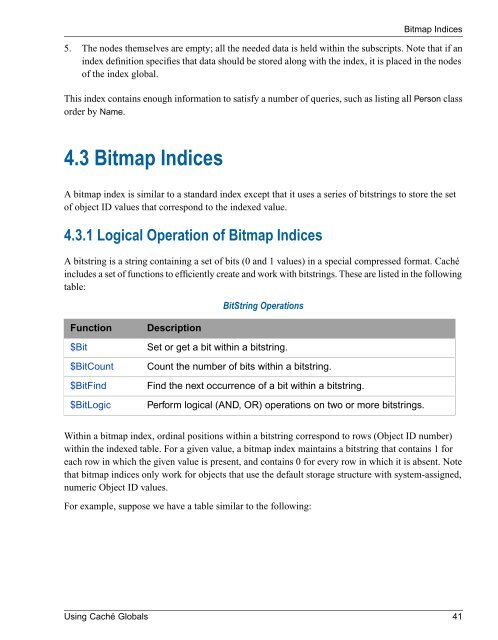Using Caché Globals - InterSystems Documentation
Using Caché Globals - InterSystems Documentation
Using Caché Globals - InterSystems Documentation
You also want an ePaper? Increase the reach of your titles
YUMPU automatically turns print PDFs into web optimized ePapers that Google loves.
Bitmap Indices5. The nodes themselves are empty; all the needed data is held within the subscripts. Note that if anindex definition specifies that data should be stored along with the index, it is placed in the nodesof the index global.This index contains enough information to satisfy a number of queries, such as listing all Person classorder by Name.4.3 Bitmap IndicesA bitmap index is similar to a standard index except that it uses a series of bitstrings to store the setof object ID values that correspond to the indexed value.4.3.1 Logical Operation of Bitmap IndicesA bitstring is a string containing a set of bits (0 and 1 values) in a special compressed format. <strong>Caché</strong>includes a set of functions to efficiently create and work with bitstrings. These are listed in the followingtable:BitString OperationsFunction$Bit$BitCount$BitFind$BitLogicDescriptionSet or get a bit within a bitstring.Count the number of bits within a bitstring.Find the next occurrence of a bit within a bitstring.Perform logical (AND, OR) operations on two or more bitstrings.Within a bitmap index, ordinal positions within a bitstring correspond to rows (Object ID number)within the indexed table. For a given value, a bitmap index maintains a bitstring that contains 1 foreach row in which the given value is present, and contains 0 for every row in which it is absent. Notethat bitmap indices only work for objects that use the default storage structure with system-assigned,numeric Object ID values.For example, suppose we have a table similar to the following:<strong>Using</strong> <strong>Caché</strong> <strong>Globals</strong> 41

















